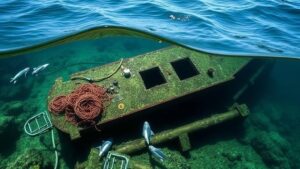Rediscovering Relics in Lost Maritime Cargo Storage Warehouses
Rediscovering Relics in Lost Maritime Cargo Storage Warehouses
The historic preservation and documentation of maritime cargo storage warehouses are crucial for understanding the maritime trade routes and economic landscapes of the past. This article explores the rediscovery of relics from lost maritime cargo storage warehouses, significant in their contributions to maritime archaeology and history. It provides a comprehensive overview of methodologies, findings, and the implications of these discoveries on current and future studies.
Historical Context of Maritime Cargo Storage
Maritime cargo storage warehouses have played an instrumental role in the development of trade economies throughout history. Originating in the 14th century, these structures were primarily found in port cities such as Venice, Genoa, and later, colonial American ports like Philadelphia and New York. For example, the Pennsylvania Historical and Museum Commission notes that the warehouse structures in Philadelphia served essential functions during the American Revolution, allowing for secure storage of supplies and armament.
Methodologies for Rediscovery
The methodologies employed in the rediscovery of these relics can be categorized into four main areas: archival research, underwater archaeology, ground-penetrating radar (GPR), and community engagement.
- Archival Research: Historical documents, shipping logs, and maps are examined to pinpoint the locations and functions of warehouses. For example, archives of the British East India Company illuminate on the variety of goods stored and their subsequent trade routes.
- Underwater Archaeology: Many warehouses have fallen into disrepair or submerged due to coastal changes. Techniques such as remotely operated vehicles (ROVs) are employed to investigate submerged sites.
- Ground-Penetrating Radar (GPR): This technology allows archaeologists to detect buried structures without excavation, preserving the integrity of the site while mapping out the potential remains.
- Community Engagement: Local historians and communities are often vital in sharing oral histories and records that may not have formal documentation. This aspect helps in the contextual rediscovery of relics.
Case Study: The Baltimore Maritime Warehouse
In 2018, a significant project to rediscover the relics of the Baltimore Maritime Warehouse was undertaken following an accidental discovery during urban redevelopment. The warehouse, originally constructed in 1790, was central to the shipping of tobacco and grain during the 19th century.
Using GPR, archaeologists successfully mapped buried artifacts such as barrels, tools, and portions of the dock structure, yielding insights into the types of cargo handled there. e findings coincide with historical accounts by the Maryland State Archives, showcasing trade dynamics of the era.
Implications of Rediscovered Relics
The implications of rediscovering relics from lost maritime cargo storage warehouses extend beyond academic curiosity. They provide valuable context for maritime history and contribute to a broader understanding of economic conditions, trade practices, and cultural exchanges. The integration of archaeological findings with historical records enhances our comprehension of past societies and environments.
Challenges and Considerations
While the rediscovery of these relics is invaluable, several challenges must be addressed:
- Preservation: Environmental factors and human activities pose threats to the integrity of these sites. Effective conservation strategies are needed to ensure long-term preservation.
- Funding: Many projects face financial constraints, limiting the scope of research and excavation efforts. Collaborations with universities and governmental organizations can alleviate some of these challenges.
- Public Awareness: Engaging the public in maritime heritage can foster appreciation and support for preservation efforts. Educational outreach programs can garner local interest and investment.
Conclusion and Actionable Takeaways
The rediscovery of relics in lost maritime cargo storage warehouses is essential for conserving maritime heritage. Research methodologies, case studies, and community involvement play fundamental roles in uncovering the rich history of maritime trade. As we move forward, preserving these historical sites and integrating their findings into public consciousness will remain paramount.
To encourage the continuation of this research field, stakeholders are encouraged to:
- Invest in multidisciplinary approaches that combine archaeology, history, and technology.
- Seek partnerships with local communities to promote awareness and support.
- Advocate for funding opportunities within academic and governmental frameworks to sustain preservation efforts.
Through these initiatives, the maritime legacy embodied in these lost warehouses can be salvaged and appreciated for generations to come.



